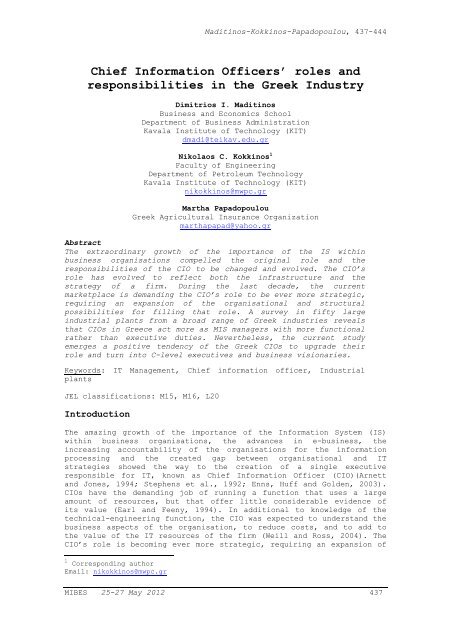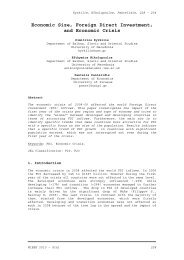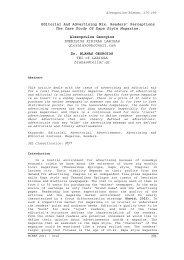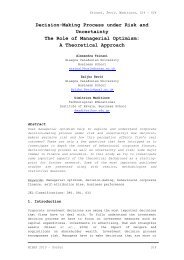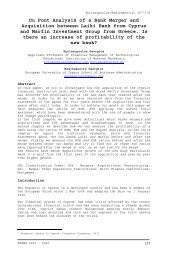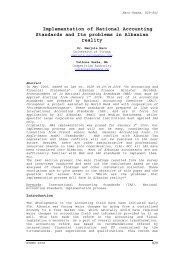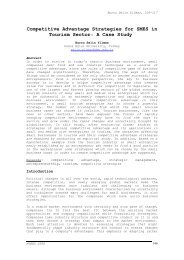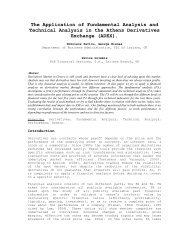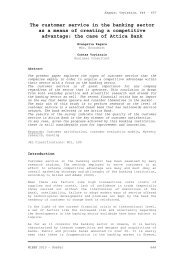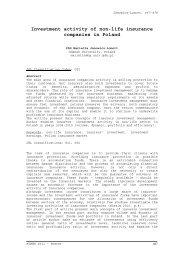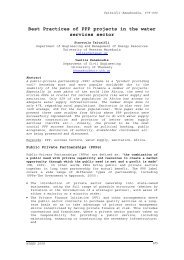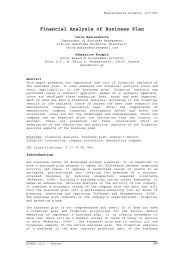roles and responsibilities in the Greek Industry - mibes
roles and responsibilities in the Greek Industry - mibes
roles and responsibilities in the Greek Industry - mibes
Create successful ePaper yourself
Turn your PDF publications into a flip-book with our unique Google optimized e-Paper software.
Madit<strong>in</strong>os-Kokk<strong>in</strong>os-Papadopoulou, 437-444<br />
Chief Information Officers’ <strong>roles</strong> <strong>and</strong><br />
<strong>responsibilities</strong> <strong>in</strong> <strong>the</strong> <strong>Greek</strong> <strong>Industry</strong><br />
Dimitrios I. Madit<strong>in</strong>os<br />
Bus<strong>in</strong>ess <strong>and</strong> Economics School<br />
Department of Bus<strong>in</strong>ess Adm<strong>in</strong>istration<br />
Kavala Institute of Technology (KIT)<br />
dmadi@teikav.edu.gr<br />
Nikolaos C. Kokk<strong>in</strong>os 1<br />
Faculty of Eng<strong>in</strong>eer<strong>in</strong>g<br />
Department of Petroleum Technology<br />
Kavala Institute of Technology (KIT)<br />
nikokk<strong>in</strong>os@mwpc.gr<br />
Martha Papadopoulou<br />
<strong>Greek</strong> Agricultural Insurance Organization<br />
marthapapad@yahoo.gr<br />
Abstract<br />
The extraord<strong>in</strong>ary growth of <strong>the</strong> importance of <strong>the</strong> IS with<strong>in</strong><br />
bus<strong>in</strong>ess organisations compelled <strong>the</strong> orig<strong>in</strong>al role <strong>and</strong> <strong>the</strong><br />
<strong>responsibilities</strong> of <strong>the</strong> CIO to be changed <strong>and</strong> evolved. The CIO’s<br />
role has evolved to reflect both <strong>the</strong> <strong>in</strong>frastructure <strong>and</strong> <strong>the</strong><br />
strategy of a firm. Dur<strong>in</strong>g <strong>the</strong> last decade, <strong>the</strong> current<br />
marketplace is dem<strong>and</strong><strong>in</strong>g <strong>the</strong> CIO’s role to be ever more strategic,<br />
requir<strong>in</strong>g an expansion of <strong>the</strong> organisational <strong>and</strong> structural<br />
possibilities for fill<strong>in</strong>g that role. A survey <strong>in</strong> fifty large<br />
<strong>in</strong>dustrial plants from a broad range of <strong>Greek</strong> <strong>in</strong>dustries reveals<br />
that CIOs <strong>in</strong> Greece act more as MIS managers with more functional<br />
ra<strong>the</strong>r than executive duties. Never<strong>the</strong>less, <strong>the</strong> current study<br />
emerges a positive tendency of <strong>the</strong> <strong>Greek</strong> CIOs to upgrade <strong>the</strong>ir<br />
role <strong>and</strong> turn <strong>in</strong>to C-level executives <strong>and</strong> bus<strong>in</strong>ess visionaries.<br />
Keywords: IT Management, Chief <strong>in</strong>formation officer, Industrial<br />
plants<br />
JEL classifications: M15, M16, L20<br />
Introduction<br />
The amaz<strong>in</strong>g growth of <strong>the</strong> importance of <strong>the</strong> Information System (IS)<br />
with<strong>in</strong> bus<strong>in</strong>ess organisations, <strong>the</strong> advances <strong>in</strong> e-bus<strong>in</strong>ess, <strong>the</strong><br />
<strong>in</strong>creas<strong>in</strong>g accountability of <strong>the</strong> organisations for <strong>the</strong> <strong>in</strong>formation<br />
process<strong>in</strong>g <strong>and</strong> <strong>the</strong> created gap between organisational <strong>and</strong> IT<br />
strategies showed <strong>the</strong> way to <strong>the</strong> creation of a s<strong>in</strong>gle executive<br />
responsible for IT, known as Chief Information Officer (CIO)(Arnett<br />
<strong>and</strong> Jones, 1994; Stephens et al., 1992; Enns, Huff <strong>and</strong> Golden, 2003).<br />
CIOs have <strong>the</strong> dem<strong>and</strong><strong>in</strong>g job of runn<strong>in</strong>g a function that uses a large<br />
amount of resources, but that offer little considerable evidence of<br />
its value (Earl <strong>and</strong> Feeny, 1994). In additional to knowledge of <strong>the</strong><br />
technical-eng<strong>in</strong>eer<strong>in</strong>g function, <strong>the</strong> CIO was expected to underst<strong>and</strong> <strong>the</strong><br />
bus<strong>in</strong>ess aspects of <strong>the</strong> organisation, to reduce costs, <strong>and</strong> to add to<br />
<strong>the</strong> value of <strong>the</strong> IT resources of <strong>the</strong> firm (Weill <strong>and</strong> Ross, 2004). The<br />
CIO’s role is becom<strong>in</strong>g ever more strategic, requir<strong>in</strong>g an expansion of<br />
1<br />
Correspond<strong>in</strong>g author<br />
Email: nikokk<strong>in</strong>os@mwpc.gr<br />
MIBES 25-27 May 2012 437
Madit<strong>in</strong>os-Kokk<strong>in</strong>os-Papadopoulou, 437-444<br />
<strong>the</strong> organisational <strong>and</strong> structural possibilities for fill<strong>in</strong>g that role<br />
(Robson, 1997). Accord<strong>in</strong>g to Hoffman (1998) <strong>the</strong> firms reshape <strong>the</strong> IS<br />
executive role itself <strong>and</strong> many of <strong>the</strong>m looked for outsourc<strong>in</strong>g<br />
solutions (Applegate <strong>and</strong> Elam, 1992).<br />
In this study, a survey took place <strong>in</strong> order to <strong>in</strong>dentify <strong>the</strong> role, <strong>the</strong><br />
<strong>responsibilities</strong> <strong>and</strong> <strong>the</strong> nature of contacts of <strong>the</strong> CIO <strong>in</strong> <strong>the</strong> <strong>Greek</strong><br />
<strong>in</strong>dustry. Throughout this survey, primary data from several <strong>in</strong>terviews<br />
<strong>and</strong> observations were ga<strong>the</strong>red from fifty large <strong>in</strong>dustrial plants <strong>in</strong><br />
Greece.<br />
Theoretical Background<br />
The <strong>in</strong>ternal need of <strong>the</strong> companies to develop capabilities through <strong>the</strong><br />
<strong>in</strong>tegration of <strong>the</strong>ir technical resources; <strong>and</strong> also, <strong>the</strong> external new<br />
competitive bus<strong>in</strong>ess challenges <strong>and</strong> opportunities have motivated<br />
bus<strong>in</strong>ess executives to count on <strong>the</strong> IS executive to use <strong>the</strong> IT<br />
resources of <strong>the</strong> company for driv<strong>in</strong>g strategic change. Thus, <strong>the</strong><br />
extraord<strong>in</strong>ary growth of <strong>the</strong> importance of <strong>the</strong> IS with<strong>in</strong> bus<strong>in</strong>ess<br />
organisations compelled <strong>the</strong> orig<strong>in</strong>al role <strong>and</strong> <strong>the</strong> <strong>responsibilities</strong> of<br />
<strong>the</strong> IS manager (more likely data process<strong>in</strong>g-technology manager) <strong>in</strong> <strong>the</strong><br />
1950s <strong>and</strong> 1960s to be changed <strong>and</strong> evolved.<br />
The role of <strong>the</strong> CIO<br />
In <strong>the</strong> beg<strong>in</strong>n<strong>in</strong>g, IS managers worked <strong>in</strong> major companies as functional<br />
heads <strong>and</strong> <strong>the</strong>ir role was more technology-centric, closely to <strong>the</strong> role<br />
of a computer educated technician. In <strong>the</strong> end of 1970s, <strong>the</strong> MIS<br />
(Management Information Systems) had been even more matured <strong>and</strong> <strong>the</strong><br />
role of <strong>the</strong> MIS managers had been connected with <strong>the</strong> measures of<br />
system efficiency <strong>and</strong> cost reduction (Ives <strong>and</strong> Olson, 1981). By <strong>the</strong><br />
beg<strong>in</strong>n<strong>in</strong>g of 1980s, MIS managers exhibited tendency for provid<strong>in</strong>g <strong>the</strong><br />
CEOs with important <strong>in</strong>formation regard<strong>in</strong>g <strong>the</strong> adaption of <strong>the</strong><br />
organisation to new technologies (Rockart, 1980). Then <strong>in</strong> <strong>the</strong> mid-<br />
1990s, <strong>the</strong> title of CIO was <strong>in</strong>troduced to describe a new type of IS<br />
executive <strong>in</strong> a C-level position. The CIOs became strategic partners<br />
for align<strong>in</strong>g IT with bus<strong>in</strong>ess <strong>and</strong> many studies revealed that an<br />
<strong>in</strong>creas<strong>in</strong>g number of CIOs reported directly to <strong>the</strong> CEO <strong>and</strong> over half<br />
became senior managers (Feeny, Edwards <strong>and</strong> Simpson, 1992; Chun <strong>and</strong><br />
Mooney, 2009). CIOs had begun to undertake activities to achieve <strong>the</strong><br />
objectives of <strong>the</strong> organisation (Robson, 1997). Eventually, <strong>the</strong>ir role<br />
differed from <strong>the</strong> role typically referred to as MIS manager <strong>and</strong> <strong>the</strong>y<br />
operated more as executives ra<strong>the</strong>r than functional managers (Stephens<br />
et al., 1992). Fur<strong>the</strong>rmore, Jordan (1993) stated that CIO is concerned<br />
with a wider group of issues than are most managers. In <strong>the</strong> 2000s, <strong>the</strong><br />
CIOs turn <strong>in</strong>to bus<strong>in</strong>ess visionaries <strong>in</strong>itiat<strong>in</strong>g bus<strong>in</strong>esses to change<br />
processes <strong>and</strong> strategies with <strong>the</strong> use of IT (Rockart, 1980; Enns, Huff<br />
<strong>and</strong> Golden, 2003; Feeny, Edwards <strong>and</strong> Simpson, 1992). CIOs began to<br />
diversify <strong>the</strong>ir <strong>responsibilities</strong> <strong>and</strong> <strong>the</strong>y came closer with <strong>the</strong><br />
bus<strong>in</strong>ess units <strong>in</strong> order to take advantage of <strong>the</strong> opportunities <strong>in</strong> <strong>the</strong><br />
marketplace.<br />
MIBES 25-27 May 2012 438
Madit<strong>in</strong>os-Kokk<strong>in</strong>os-Papadopoulou, 437-444<br />
CIO<br />
Credibility<br />
Level 1:<br />
Functional<br />
head<br />
---<br />
Deliver on<br />
promises<br />
Level 2:<br />
Strategic<br />
partner<br />
---<br />
Align IT<br />
with<br />
bus<strong>in</strong>ess<br />
1950 1990 2000<br />
Level 3:<br />
Bus<strong>in</strong>ess<br />
visionary<br />
---<br />
Drive<br />
strategy<br />
Figure 1: The evolution of <strong>the</strong> CIO’s role<br />
?<br />
Organisational<br />
Learn<strong>in</strong>g<br />
The whole evolution of <strong>the</strong> CIO’s role is illustrated <strong>in</strong> Figure 1. This<br />
model was first proposed by Hirschheim et al. (1988), subsequently<br />
developed by Fenny (1997) <strong>and</strong> <strong>the</strong>n, many researchers reused it (Ross<br />
<strong>and</strong> Fenny, 1999; Chun <strong>and</strong> Mooney, 2009). Figure 2 shows our adapted<br />
version, which <strong>in</strong>cludes <strong>the</strong> time division.<br />
Ma<strong>in</strong> doma<strong>in</strong>s of <strong>responsibilities</strong> of <strong>the</strong> CIO<br />
CIO is not only a provider of technological services to user<br />
departments, but is a manager of people, as well. Accord<strong>in</strong>g to Robson<br />
(1997), managers undertake activities to achieve <strong>the</strong> purposes of <strong>the</strong><br />
organisations. M<strong>in</strong>tzberg (1994) noticed that many authors emphasised<br />
one particular part of <strong>the</strong> manager’s job <strong>and</strong> exclude <strong>the</strong> o<strong>the</strong>rs. Some<br />
of <strong>the</strong>m say that good managers are really leaders, o<strong>the</strong>rs that are<br />
doers, o<strong>the</strong>rs that are th<strong>in</strong>kers <strong>and</strong> some o<strong>the</strong>rs that are essentially<br />
controllers. Perhaps, toge<strong>the</strong>r cover <strong>the</strong> greater part of <strong>the</strong> whole job<br />
of manag<strong>in</strong>g.<br />
Hence, CIO needs to be characterised by a number of capabilities <strong>in</strong><br />
order to be successful with its role. Figure 2 illustrates <strong>the</strong> IS<br />
capabilities that compose <strong>the</strong> role of a CIO <strong>and</strong> <strong>the</strong>y have been grouped<br />
<strong>in</strong>to three ma<strong>in</strong> doma<strong>in</strong>s of responsibility (bus<strong>in</strong>ess, technology,<br />
service). Feeny <strong>and</strong> Willcocks (1998), based upon <strong>in</strong>terviews with 61<br />
CIOs, identified n<strong>in</strong>e IS capabilities that <strong>the</strong> CIO’s role requires<br />
with<strong>in</strong> <strong>the</strong> above three ma<strong>in</strong> doma<strong>in</strong>s of <strong>responsibilities</strong>: leadership<br />
(<strong>in</strong>tegrat<strong>in</strong>g IS/IT effort with bus<strong>in</strong>ess purpose <strong>and</strong> activity),<br />
bus<strong>in</strong>ess systems th<strong>in</strong>k<strong>in</strong>g (comb<strong>in</strong><strong>in</strong>g <strong>the</strong> bus<strong>in</strong>ess strategy <strong>and</strong><br />
technology application), relationship build<strong>in</strong>g (bridg<strong>in</strong>g <strong>the</strong> culture<br />
gap of all parties between bus<strong>in</strong>ess <strong>and</strong> technology doma<strong>in</strong>s),<br />
architecture plann<strong>in</strong>g (develop<strong>in</strong>g responsive bluepr<strong>in</strong>t for present <strong>and</strong><br />
future bus<strong>in</strong>ess needs), mak<strong>in</strong>g technology work (satisfy<strong>in</strong>g timely<br />
bus<strong>in</strong>ess needs by trouble-shoot<strong>in</strong>g problems), <strong>in</strong>formed buy<strong>in</strong>g<br />
(manag<strong>in</strong>g <strong>the</strong> IS/IT purchas<strong>in</strong>g or outsourc<strong>in</strong>g strategy accord<strong>in</strong>g to<br />
bus<strong>in</strong>ess needs), contract facilitation (guarantee<strong>in</strong>g <strong>the</strong> success of<br />
exist<strong>in</strong>g contracts for IS/IT services), contract monitor<strong>in</strong>g<br />
(protect<strong>in</strong>g <strong>the</strong> bus<strong>in</strong>ess’s contractual position) <strong>and</strong> vendor<br />
development (identify<strong>in</strong>g <strong>the</strong> potential added value of IS/IT service<br />
providers). In addition, Sobol <strong>and</strong> Kle<strong>in</strong> (2009) mentioned that<br />
relationships exist between CIO characteristics <strong>and</strong> <strong>the</strong> IT<br />
MIBES 25-27 May 2012 439
Madit<strong>in</strong>os-Kokk<strong>in</strong>os-Papadopoulou, 437-444<br />
<strong>in</strong>frastructure of a firm, as well as with <strong>the</strong> f<strong>in</strong>ancial performance of<br />
a company.<br />
Figure 2: The three ma<strong>in</strong> doma<strong>in</strong>s of CIOs’ <strong>responsibilities</strong> <strong>and</strong> <strong>the</strong><br />
<strong>in</strong>cluded CIOs’ needful capabilities (Feeny <strong>and</strong> Willcocks, 1998)<br />
Methodology<br />
Tak<strong>in</strong>g <strong>in</strong>to consideration <strong>the</strong> above-mentioned <strong>the</strong>oretical background,<br />
an <strong>in</strong>tegrative survey was designed <strong>and</strong> took place <strong>in</strong> fifty (50) <strong>Greek</strong><br />
large <strong>in</strong>dustrial plants (Table 1). The objective of this study is to<br />
exam<strong>in</strong>e thoroughly <strong>the</strong> <strong>responsibilities</strong> that <strong>the</strong> CIOs undertake <strong>in</strong> <strong>the</strong><br />
<strong>Greek</strong> <strong>in</strong>dustry <strong>and</strong> to focus on <strong>the</strong> f<strong>in</strong>al form of <strong>the</strong>ir role.<br />
Table 1: Profile of <strong>the</strong> firms<br />
Employees<br />
Frequency<br />
Percent Cumulative Percent<br />
Less than 100 22 44.0 44.0<br />
100 to 199 20 40.0 84.0<br />
200 or more 8 16.0 100.0<br />
Total 50 100.0<br />
Experience <strong>in</strong> <strong>the</strong>ir field<br />
Frequency<br />
Percent Cumulative Percent<br />
Less than 5 years 4 8.0 8.0<br />
5 to 10 years 22 44.0 52.0<br />
More than 10 years 24 48.0 100.0<br />
Total 50 100.0<br />
The survey was conducted by <strong>in</strong>-depth <strong>in</strong>terviews with <strong>the</strong> CIOs <strong>and</strong>/or<br />
system adm<strong>in</strong>istrators <strong>and</strong> afterwards by several observations on <strong>the</strong><br />
spot. A first contact type of e-mail with an attached automatedelectronic<br />
form was sent to many CIOs, system adm<strong>in</strong>istrators <strong>and</strong> IT<br />
consultants <strong>in</strong> Greece. The particular electronic form <strong>in</strong>formed <strong>the</strong><br />
receivers about <strong>the</strong> subject, <strong>the</strong> questions <strong>and</strong> <strong>the</strong> purpose of <strong>the</strong><br />
<strong>in</strong>terview. Then, each company completed <strong>the</strong> form <strong>and</strong> sent it back to<br />
<strong>the</strong> author by e-mail. After <strong>the</strong> first data ga<strong>the</strong>r<strong>in</strong>g by e-mail,<br />
several <strong>in</strong>terviews (some of <strong>the</strong>m by telephone or net-meet<strong>in</strong>g<br />
MIBES 25-27 May 2012 440
Madit<strong>in</strong>os-Kokk<strong>in</strong>os-Papadopoulou, 437-444<br />
communication, due to <strong>the</strong> big distances) with <strong>the</strong> CIO of <strong>the</strong> firms<br />
were arranged <strong>in</strong> order to illum<strong>in</strong>ate every obscure corner of <strong>the</strong><br />
study. The <strong>in</strong>terviews <strong>and</strong> <strong>the</strong> observations provided primary data on<br />
<strong>the</strong> CIOs’ perspective, <strong>the</strong>ir <strong>in</strong>terpretations of <strong>the</strong>ir current role <strong>and</strong><br />
<strong>responsibilities</strong>, <strong>and</strong> outlooks on <strong>the</strong> attributes required to be<br />
successful <strong>in</strong> <strong>the</strong> role. Eventually, all <strong>the</strong> collected data (ga<strong>the</strong>red<br />
by e-mails, <strong>in</strong>terviews <strong>and</strong> observations) were structured, tabulated<br />
<strong>and</strong> encoded by two different statistical software applications <strong>in</strong> <strong>the</strong><br />
Process Simulations <strong>and</strong> Statistical Analysis Labs, at <strong>the</strong> Department<br />
of Petroleum Technology, of Kavala Institute of Technology (KIT).<br />
Results <strong>and</strong> discussion<br />
The exam<strong>in</strong>ed sample <strong>in</strong>cluded fifty (50) CIOs from a broad range of<br />
<strong>Greek</strong> <strong>in</strong>dustries (construction, service, petroleum, agricultural).<br />
Approximately, half of <strong>the</strong> exam<strong>in</strong>ed CIOs were IT graduates <strong>and</strong> <strong>the</strong>y<br />
hold a higher degree than a Bachelor (Table 2).<br />
Table 2: CIOs’ educational background<br />
IT Graduate<br />
Frequency Percent Cumulative Percent<br />
No 26 52.0 52.0<br />
Yes 24 48.0 100.0<br />
Total 50 100.0<br />
Education<br />
Frequency Percent Cumulative Percent<br />
Bachelor 31 56.0 56.0<br />
Master 19 38.0 94.0<br />
Doctorate 3 6.0 100.0<br />
Total 50 100.0<br />
The exam<strong>in</strong>ed CIOs were asked to identify <strong>the</strong> nature of <strong>the</strong>ir contacts<br />
<strong>and</strong> allocate <strong>the</strong> time <strong>the</strong>y spent on <strong>the</strong>m <strong>in</strong> a daily base. Then, <strong>the</strong><br />
contacts were categorized by media <strong>and</strong> location <strong>and</strong> <strong>the</strong> time was<br />
computed as a percent of eight (8) work<strong>in</strong>g hours per day. Accord<strong>in</strong>g to<br />
Table 3, most of <strong>the</strong> CIOs’ daily work<strong>in</strong>g hours were spent on schedule<br />
meet<strong>in</strong>gs <strong>and</strong> telephone calls; <strong>and</strong> more than <strong>the</strong> half percentage of<br />
<strong>the</strong>ir daily contact time was spent on <strong>the</strong>ir own offices <strong>and</strong> rarely,<br />
<strong>the</strong>y were outside <strong>the</strong> organisation. In contrast, Stephens et al.<br />
(1992) observed that CIOs spend more time away from <strong>the</strong>ir<br />
offices/organisations <strong>and</strong> less time on <strong>the</strong>ir offices, while MIS<br />
managers allocate <strong>the</strong>ir daily work<strong>in</strong>g time vice versa <strong>and</strong> <strong>the</strong>y also<br />
spent around <strong>the</strong> half of <strong>the</strong>ir time on scheduled meet<strong>in</strong>gs.<br />
MIBES 25-27 May 2012 441
Madit<strong>in</strong>os-Kokk<strong>in</strong>os-Papadopoulou, 437-444<br />
Table 3: The nature of CIO contacts<br />
Media Time allocation of CIOs (%)<br />
Telephone calls 30<br />
Scheduled meet<strong>in</strong>gs 57<br />
Unscheduled meet<strong>in</strong>gs 9<br />
Tours 4<br />
Total 100<br />
Location Time allocation of CIOs (%)<br />
Own office 56<br />
O<strong>the</strong>r’s office 5<br />
Plant 15<br />
Conference room 20<br />
Away from organisation 4<br />
Total 100<br />
Dur<strong>in</strong>g <strong>the</strong> <strong>in</strong>terviews, <strong>the</strong> CIOs were asked to identify <strong>the</strong>ir role <strong>and</strong><br />
<strong>the</strong>ir attributes, <strong>and</strong> to describe how <strong>the</strong>y spend <strong>the</strong>ir time <strong>in</strong> a<br />
typical month. Accord<strong>in</strong>g to <strong>the</strong> evidence took out from <strong>the</strong> <strong>in</strong>terviews<br />
with <strong>the</strong> CIOs, <strong>the</strong> extracted <strong>in</strong>formation was encoded <strong>and</strong> categorised,<br />
regard<strong>in</strong>g its <strong>the</strong>me, <strong>in</strong>to <strong>the</strong> n<strong>in</strong>e IS capabilities. Thus, capabilities<br />
with occurrences below 35 were categorised as “weak support”,<br />
capabilities with 35-84 occurrences were categorised as “some support”<br />
<strong>and</strong> capabilities with 85 or more occurrences were categorised as<br />
“strong support”. The frequency of <strong>the</strong> CIOs’ activities was estimated<br />
by count<strong>in</strong>g <strong>the</strong> recorded occurrences <strong>and</strong> eventually, <strong>the</strong> empirical<br />
support of <strong>the</strong> CIO’s capabilities is shown <strong>in</strong> Figure 3. Three of <strong>the</strong><br />
n<strong>in</strong>e IS capabilities are strongly supported by <strong>the</strong> exam<strong>in</strong>ed CIOs:<br />
relationship build<strong>in</strong>g, mak<strong>in</strong>g technology work <strong>and</strong> contract<br />
facilitation. In general, <strong>the</strong>se <strong>responsibilities</strong> were delegated to<br />
lower-level IT managers (Chun <strong>and</strong> Mooney, 2009). Fur<strong>the</strong>rmore, <strong>the</strong> IS<br />
capabilities: bus<strong>in</strong>ess systems th<strong>in</strong>k<strong>in</strong>g, architecture plann<strong>in</strong>g <strong>and</strong><br />
leadership receive some support by <strong>the</strong> sample of CIOs; however, <strong>the</strong><br />
occurrences of <strong>the</strong>se capabilities are 83, that is very close to <strong>the</strong><br />
lower limit of <strong>the</strong> “strong support” level. The above empirical results<br />
reflect <strong>the</strong> fact that <strong>the</strong> CIO’s role <strong>in</strong> <strong>the</strong> <strong>Greek</strong> <strong>in</strong>dustry is more a<br />
technology-centric role, but it emerges a positive tendency to upgrade<br />
to <strong>the</strong> third stage of CIO’s role evolution, which is a role that<br />
belongs to C-level executives or to bus<strong>in</strong>ess visionaries.<br />
MIBES 25-27 May 2012 442
Madit<strong>in</strong>os-Kokk<strong>in</strong>os-Papadopoulou, 437-444<br />
Figure 3: Empirical support of CIOs’ capabilities by our sample<br />
(Feeny, Edwards <strong>and</strong> Simpson, 1992)<br />
Conclusions<br />
Tak<strong>in</strong>g everyth<strong>in</strong>g <strong>in</strong>to consideration, several useful <strong>and</strong> remarkable<br />
conclusions could be drawn from <strong>the</strong> current survey. The today CIOs’<br />
role <strong>in</strong> <strong>the</strong> <strong>Greek</strong> <strong>in</strong>dustry represents <strong>the</strong> role of CIOs <strong>in</strong> <strong>the</strong> end of<br />
1990s, which was more functional <strong>and</strong> technology-centric role than a<br />
strategic one. It seems that CIOs <strong>in</strong> Greece act more as MIS managers<br />
with more functional ra<strong>the</strong>r than executive duties. However, <strong>the</strong><br />
current study emerges a positive tendency of <strong>the</strong> <strong>Greek</strong> CIOs to upgrade<br />
<strong>the</strong>ir role to <strong>the</strong> third stage of CIO’s role evolution, which is a role<br />
that belongs to C-level executives or to bus<strong>in</strong>ess visionaries. A<br />
better allocation of <strong>the</strong> <strong>Greek</strong> CIOs’ daily work<strong>in</strong>g time <strong>and</strong> perhaps,<br />
<strong>the</strong> development of new IT departments, which would be dedicated to<br />
specific duties, would alleviate <strong>the</strong> CIOs’ burden <strong>and</strong> make <strong>the</strong>m more<br />
productive, efficient <strong>and</strong> eventually, bus<strong>in</strong>ess visionaries.<br />
References<br />
Applegate, L.M., <strong>and</strong> J.J. Elam, (1992), “New <strong>in</strong>formation systems<br />
leaders: A chang<strong>in</strong>g role <strong>in</strong> a chang<strong>in</strong>g world,” MIS Quarterly, 16(4),<br />
pp. 469-490<br />
Arnett, K.P., <strong>and</strong> C.J. Jones, (1994), “Firms that those outsourc<strong>in</strong>g: A<br />
profile,” Information <strong>and</strong> Management, 26(4), pp. 179-188<br />
Chun, M., <strong>and</strong> J. Mooney, (2009), “CIO <strong>roles</strong> <strong>and</strong> <strong>responsibilities</strong>:<br />
Twenty-five years of evolution <strong>and</strong> change,”<br />
Information <strong>and</strong> Management, 46(6), pp. 323-334<br />
Earl, M.J., <strong>and</strong> D.F. Feeny, (1994), “Is your CIO add<strong>in</strong>g value?,” Sloan<br />
Management Review, 35(3), pp. 11–20<br />
Enns, H.G., S.L. Huff, <strong>and</strong> B.R. Golden, (2003), “CIO <strong>in</strong>fluence<br />
behaviours: <strong>the</strong> impact of technical background,” Information <strong>and</strong><br />
Management, 40, pp. 467-485.<br />
Fenny D.F., (1997), ”The Five-year Learn<strong>in</strong>g of Ten IT Directors,” <strong>in</strong><br />
L. Willcocks, D. Feeny, <strong>and</strong> G. Islei (eds.), Manag<strong>in</strong>g IT as a<br />
Strategic Resource, McGraw-Hill, London<br />
Feeny, D., B.R. Edwards, <strong>and</strong> K.M. Simpson, 1992, “Underst<strong>and</strong><strong>in</strong>g <strong>the</strong><br />
CEO/CIO relationship,” MIS Quarterly, 16(4), pp. 435–448<br />
MIBES 25-27 May 2012 443
Madit<strong>in</strong>os-Kokk<strong>in</strong>os-Papadopoulou, 437-444<br />
Feeny, D.F., <strong>and</strong> L.P. Willcocks, (1998), “Core IS capabilities for<br />
exploit<strong>in</strong>g <strong>in</strong>formation technology,” Sloan Management Review, 39(3),<br />
9–21<br />
Feeny, D. F., <strong>and</strong> L.P. Willcocks, (1998), “Re-design<strong>in</strong>g <strong>the</strong> IS<br />
function around core capabilities,” Long Range Plann<strong>in</strong>g, 31(3), pp.<br />
354-367<br />
Hirschheim, R., M. Earl, D. Feeny, <strong>and</strong> M. Lockett, (1988), "An<br />
Exploration <strong>in</strong>to <strong>the</strong> Management of <strong>the</strong> Information Systems Function:<br />
Key Issues <strong>and</strong> an Evolutionary Model,” Information Technology<br />
Management for Productivity <strong>and</strong> Competitive Advantage, IFIP TC-8<br />
Open Conference, S<strong>in</strong>gapore<br />
Hoffman, T. (1998), “Too many IT duties? Hire a second CIO,”<br />
Computerworld, 32(11), 10<br />
Ives, B., <strong>and</strong> M.H. Olson, (1981), “Manager or technician? The nature<br />
of <strong>the</strong> <strong>in</strong>formation systems manager’s job,” MIS Quarterly, 5(4), pp.<br />
49-63<br />
Jordan, E., (1993), “Executive <strong>in</strong>formation systems for <strong>the</strong> chief<br />
<strong>in</strong>formation officer,” International Journal of Information<br />
Management, 13(4), pp. 249-259<br />
M<strong>in</strong>tzberg, H., (1994), “Round<strong>in</strong>g out <strong>the</strong> manager’s job,” Sloan<br />
Management Review, 36(1), 11-26<br />
Robson, W., (1997), Strategic management <strong>and</strong> <strong>in</strong>formation systems, 2 nd<br />
Ed., F<strong>in</strong>ancial Times, Pitman Publish<strong>in</strong>g, UK<br />
Rockart, J.F., (1980), “The chang<strong>in</strong>g role of <strong>the</strong> <strong>in</strong>formation systems<br />
executive: a critical success factors perspective,” Sloan Management<br />
Review, 85, pp. 3-13<br />
Ross, J.W., <strong>and</strong> D.F. Fenny, (1999), “The evolv<strong>in</strong>g role of <strong>the</strong> CIO,”<br />
CISR WP No. 308<br />
Sobol, M.G., <strong>and</strong> G. Kle<strong>in</strong>, (2009), “Relation of CIO background, IT<br />
<strong>in</strong>frastructure, <strong>and</strong> economic performance,” Information <strong>and</strong><br />
Management, 46(5), pp. 271-278<br />
Stephens, C.S., W.N. Ledbetter, A. Mitra, <strong>and</strong> F.N. Ford, (1992),<br />
“Executive or fuctional manager? The nature of <strong>the</strong> CIO’s job,” MIS<br />
Quarterly, 16(4), pp. 449-467<br />
Weill, P., <strong>and</strong> J.W. Ross, (2004), IT governance: How top performers<br />
manage IT decisions rights for superior results, Harvard Bus<strong>in</strong>ess<br />
School Press, Boston<br />
MIBES 25-27 May 2012 444


